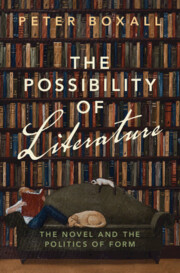Book contents
- The Possibility of Literature
- The Possibility of Literature
- Copyright page
- Dedication
- Epigraph
- Contents
- Figures
- Acknowledgements
- Introduction
- Part I On Writers
- Part II On Literary History
- Chapter 7 The Threshold of Vision
- Chapter 8 The Anatomy of Realism
- Chapter 9 Back Roads
- Chapter 10 Blind Seeing
- Chapter 11 Mere Being
- Part III On the Contemporary
- Notes
- Bibliography
- Index
Chapter 9 - Back Roads
Edgeworth. Bowen. Yeats. Beckett
from Part II - On Literary History
Published online by Cambridge University Press: 10 October 2024
- The Possibility of Literature
- The Possibility of Literature
- Copyright page
- Dedication
- Epigraph
- Contents
- Figures
- Acknowledgements
- Introduction
- Part I On Writers
- Part II On Literary History
- Chapter 7 The Threshold of Vision
- Chapter 8 The Anatomy of Realism
- Chapter 9 Back Roads
- Chapter 10 Blind Seeing
- Chapter 11 Mere Being
- Part III On the Contemporary
- Notes
- Bibliography
- Index
Summary
Throughout Beckett’s later prose and drama, in Company, Stirrings Still, …but the clouds…, there emerges at key moments the figure of the back road. Beckett’s narrator imagines a character walking in a featureless place, ‘nowhere in particular on the way from A to Z’. But then he corrects himself. ‘Or say for verisimilitude the Ballyogan Road. That dear old back road’.
This re-emergence of the back road in late Beckett calls, at each occurrence, to an Irish tradition, that has always been secreted in Beckett’s writing, somewhere in the back of the mind, or the back of the page. This essay reads this back road, as it suggests a principle of historical and cultural transmission, by which Beckett reaches backwards trough a lineage of Irish writers who sit at an angle to their own historical moment, and forwards to writers who come after Beckett, and who seek to inherit his own particular Irish legacy. The back road, and the concept of the back more generally, is a recurrent concern for writers in this tradition, from Maria Edgeworth, to Elizabeth Bowen, to John Banville. In tracing the passage of the back road from Edgeworth to Banville, this essay at once summons a minor tradition to which all of these writers belong and suggests a means by which a minor tradition might be critically articulated.
Keywords
- Type
- Chapter
- Information
- The Possibility of LiteratureThe Novel and the Politics of Form, pp. 187 - 205Publisher: Cambridge University PressPrint publication year: 2024

